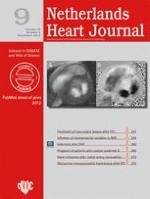01-09-2012 | Original article
Treatment of non-culprit lesions detected during primary PCI: long-term follow-up of a randomised clinical trial
Gepubliceerd in: Netherlands Heart Journal | Uitgave 9/2012
Log in om toegang te krijgenAbstract
Background
There are conflicting data regarding optimal treatment of non-culprit lesions detected during primary percutaneous coronary intervention (PCI) in patients with ST-elevation myocardial infarction (STEMI) and multi-vessel disease (MVD). We aimed to investigate whether ischaemia-driven early invasive treatment improves the long-term outcome and prevents major adverse cardiac events (MACE).
Methods
121 patients with at least one non-culprit lesion were randomised in a 2:1 manner, 80 were randomised to early fractional flow reserve (FFR)-guided PCI (invasive group), and 41 to medical treatment (conservative group). The primary endpoint was MACE at 3 years.
Results
Three-year follow-up was available in 119 patients (98.3 %). There was no significant difference in all-cause mortality between the invasive and conservative strategy, 4 patients (3.4 %) died, all in the invasive group (P = 0.29). Re-infarction occurred in 14 patients (11.8 %) in the invasive group versus none in the conservative group (p = 0.002). Re-PCI was performed in 7 patients (8.9 %) in the invasive group and in 13 patients (32.5 %) in the conservative group (P = 0.001). There was no difference in MACE between these two strategies (35.4 vs 35.0 %, p = 0.96).
Conclusions
In STEMI patients with MVD, early FFR-guided additional revascularisation of the non-culprit lesion did not reduce MACE at three-year follow-up compared with a more conservative strategy. The rate of MACE in the invasive group was predominantly driven by death and re-infarction, whereas in the conservative group the rate of MACE was only driven by repeat interventions.
